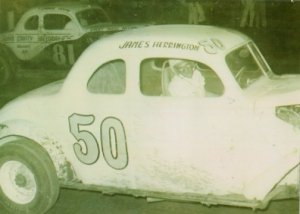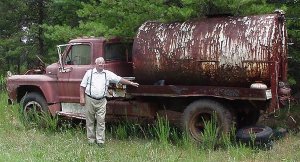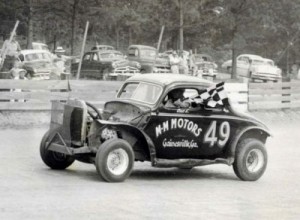Banks County Speedway

James Herrington smiles for the camera prior to a race at Banks County Speedway. That's Tommie Irvin in the number 81 behind him. Photo courtesy GARHOFA
It was around this time Tommie got into the race promoting business.
“I guess it was around 1955 or 1956 that Shelton Gailey, my brother Jack and myself started looking for a spot to build a track. We were going to put it on my place down by the river but never knew when it might flood, so finally decided to put this quarter miler kind of in a hollow, thinking we wouldn’t have to haul in much dirt, but we did anyway. Been better off just putting it in an open field,” he groaned. “There wasn’t but one track in the area running at the time, and that was Toccoa on Saturday. Anderson ran on Fridays. We built the Banks track for Wednesday nights. And we had some fun there.
“That’s where Buck Simmons really got started. Buck started racing there when he was about twelve. He was younger than that when we built the track. His daddy let him hang around there and help out at nights. He would do any odd jobs just to be a part of it. We would let him get out there in the water truck and wet the thing down,” Tommie remembered.

Irvin poses with the old water truck, which is still parked on the track's backstretch.
Jimmy Mosteller, longtime promoter in the Southeast, had his thoughts on Simmons.
“Little Buck finally wanted to race, so his dad got some Coca Cola crates and propped him up and off he went. Obviously the rules were a little slack up there, because the kid wasn’t but about twelve years old. But he could hold his own, I’ll tell you that for sure,” howled Jimmy.
Mosteller also told us there was plenty of partying at Banks County Speedway.
“There was a guy who could play the fiddle like nobody else up there and be at the races every week. Afterwards somebody would pull out the liquor and he would go to playing and we’d dance and holler. Sometimes that sort of thing would last all night. Today things are much too business like,” Jimmy laughed.
Irvin confirmed that.
“A bunch of those boys would just never leave,” he said. “Guys like Hugh Blackstock and Truman Padgett knew how to throw a party there at Banks. The drivers that came were some of the best around though. Bud Lundsford and Hugh Jones were two of them. We would always find a way to put Bud in the back so the crowds could enjoy seeing him come the front.”

Bud Lundsford takes a victory lap after a 1956 win at Banks County. Photo courtesy GARHOFA
And the bad drivers?
“Well,” said Irvin, “you have those everywhere. Everybody wants to be a race driver. One young fellow I really felt sorry for. He came there in some type of car which I guess belonged to his family, who couldn’t have had much. But this guy had a rope for a seat belt, no shoes, no shirt, a plastic helmet with no liner. The boy just wanted to race. Well, he turned over on the front straight immediately, right in front of the grandstand, climbed up on top of the car, and looked down on his dead heap like a dog that had lost a litter of pups.
“Somebody gave him a ride home to explain to his folks,” Tommie said, shaking his head with a smile.
